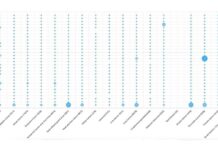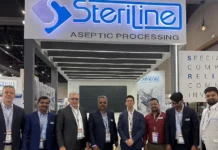Bayer and Loxo Oncology, Inc., , a biopharmaceutical company from Stamford announced the publication in The New England Journal of Medicine (NEJM) of larotrectinib data for the treatment of pediatric and adult patients whose tumors harbor Neurotrophic Tyrosine Receptor Kinase (NTRK) gene fusions.
These genetic alterations are present across a wide range of tumors resulting in uncontrolled Tropomyosin Receptor Kinase (TRK) signaling and tumor growth.
Larotrectinib was designed to directly target TRK, turning off the signaling pathway that allows TRK fusion cancers to grow. The data published in NEJM include an additional three months of patient follow-up to data presented at the 2017 American Society of Clinical Oncology (ASCO) Annual Meeting.
In data from 55 patients across the Phase I adult trial, Phase II trial (NAVIGATE), and Phase I/II pediatric trial (SCOUT), larotrectinib demonstrated an overall response rate of 75% (95% CI 61, 85) by central assessment and 80% (95% CI 67, 90) by investigator assessment. At the time of analysis, 86% of responding patients remained on larotrectinib or underwent surgery with curative intent. The median duration of response and progression-free survival had not been reached. Larotrectinib was well tolerated; the majority of all adverse events were grade 1 or 2.
“The data outlined in the NEJM publication shows the potential that larotrectinib has for patients who have TRK fusion cancers,” said David Hyman, M.D., the NAVIGATE global principal investigator, chief of the Early Drug Development service at Memorial Sloan Kettering Cancer Center and senior author of the NEJM paper. “These data warrant screening for TRK fusions in patients of all ages with advanced solid tumors.”
Bayer and Loxo Oncology are jointly developing larotrectinib for the treatment of adult and pediatric patients with TRK fusion cancers. In December 2017, Loxo Oncology initiated the submission of a rolling New Drug Application (NDA) to the U.S. Food and Drug Administration (FDA) for larotrectinib. Bayer plans to submit a Marketing Authorisation Application (MAA) in the European Union in 2018.
“NTRK gene fusions, which can be identified through gene sequencing, are rare, but present in various pediatric and adult cancers. These data showcase the potential of larotrectinib, which may benefit patients across a broad range of TRK fusion cancers,” said Scott Fields, MD, Bayer’s senior vice president and head of Oncology Development at Bayer’s Pharmaceutical Division. “We look forward to working with Health Authorities and the scientific community to make this important new treatment option available to patients as quickly as possible.”
Overview of data published in NEJM
The published data were based on the intent to treat (ITT) principle, using the first 55 NTRK gene fusion patients with RECIST-evaluable disease enrolled to the three clinical trials, regardless of prior therapy or tumor tissue diagnostic method. The analysis included both adult and pediatric patients, ranging in age from four months to 76 years, who carried 17 unique tumor diagnoses with a NTRK gene fusion. Tumor types included salivary gland, infantile fibrosarcoma, thyroid, colon, lung, melanoma, gastrointestinal stromal tumor (GIST) and other cancers.
The primary endpoint for the analysis was overall response rate (ORR). Secondary endpoints included duration of response (DOR), progression-free survival (PFS) and safety. As previously reported, the ORR was 75% by central assessment (62% partial responses, 13% completes responses) and 80% by investigator assessment (64% partial responses, 16% complete responses).
Median DOR and median PFS had not been reached after median follow-up durations of 8.3 and 9.9 months, respectively. At one year, 71% of responses were ongoing. As of the July 17, 2017 data cutoff, 86% of responding patients remained on treatment or had undergone surgery with curative intent. The first patient treated with a NTRK gene fusion tumor remained in response and on therapy at 27 months.
Larotrectinib was well tolerated with the majority of all adverse events being grade 1 or 2. Few grade 3 or 4 adverse events, regardless of attribution, were observed with the most common being anemia (11%), alanine or aspartate aminotransferase increase (7%), weight increase (7%) and neutrophil count decrease (7%) (all grade 3 events). There were no treatment-related grade 4 or 5 events, and no treatment-related grade 3 adverse events occurred in more than 5% of patients.
Eight patients required larotrectinib dose reductions. Adverse events leading to dose reductions included AST/ALT elevation, dizziness, and neutrophil count decrease, all grade 2 or 3 events. In all cases, patients whose doses were reduced maintained their best response at the lower dose and none discontinued larotrectinib due to an adverse event.
Primary resistance (defined as the best response being progressive disease) was observed in six patients in the study. Of the six, one patient had been previously treated with another TRK inhibitor and tumor sequencing prior to larotrectinib dosing revealed a solvent front mutation, a known resistance mechanism.
Tumor tissue was analyzed for three of the five remaining patients. In all three patients, TRK immunohistochemistry failed to demonstrate TRK expression, potentially implicating a false positive initial NTRK gene fusion test result and therefore explaining the lack of response in these patients.
The publication also details mechanisms of acquired resistance to larotrectinib. Ten patients experienced disease progression while on treatment after a documented objective response or stable disease for at least six months, a phenomenon known as acquired resistance. Nine of the ten patients had assessments of post-progression tumor or plasma samples, and NTRK kinase domain mutations were identified in all of those samples tested.
In seven of those assessed, investigators identified solvent front mutations as a convergent mechanism of acquired resistance; other NTRK kinase domain mutations were identified in the remaining two patients tested. Of the 10 patients who developed acquired resistance, 80% continued treatment with larotrectinib beyond progression due to ongoing clinical benefit.
As part of their agreement, Bayer and Loxo Oncology are developing LOXO-195, a next-generation TRK inhibitor, to specifically address acquired resistance mutations, including all mutations characterized in the study. LOXO-195 is currently being evaluated in a phase 1/2 trial in children and adults.




















